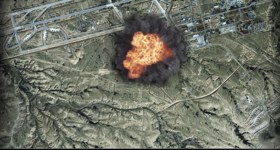21st Century Wire says…
Officials are still maintaining the line that this nuclear plant in Nebraska is safe against the recent flooding along the Missouri River, but the public can only sit back and wait to see.
If there is any disruption of service to the cooling pool for the spent fuel rods, then the region may be in serious danger…
By PETER BEHR
NYT
June 25, 2011
Pictures of the Fort Calhoun nuclear power plant north of Omaha, Neb., show it encircled by the swollen waters of the Missouri River, which reached a height of nearly 1,007 feet above sea level at the plant yesterday.
The plant’s defenses include new steel gates and other hard barriers protecting an auxiliary building with vital reactor controls, and a water-filled berm 8 feet tall that encircles other parts of the plant. Both systems are designed to hold back floodwaters reaching 1,014 feet above sea level. Additional concrete barriers and permanent berms, more sandbags and another power line into the plant have been added. The plant was shut down in April for refueling and will remain so until the flood threat is passed.
.
“Today the plant is well positioned to ride out the current extreme Missouri River flooding while keeping the public safe,” Nuclear Regulatory Commission spokesman Victor Dricks said on an agency blog this week.
But a year ago, those new defenses were not in place, and the plant’s hard barriers could have failed against a 1,010-foot flood, the Nuclear Regulatory Commission contends in a yearlong inspection and enforcement action against the plant’s operator, the Omaha Public Power District (OPPD).
“This is the first test of the revised flood preparations for Fort Calhoun,” OPPD spokesman Michael Jones said.
NRC inspectors concluded that at flooding levels above 1,008 feet, the plant “would experience a loss of offsite power and loss of intake structure” and water pumps providing essential cooling water to the plant. In that case, “the plant would be incapable of reaching cold shutdown” with normal operations — a fundamental safety requirement imposed by the NRC. The commission’s Region IV office in Arlington, Texas, issued a notice of violation against the plant on Oct. 6 last year, finding that the issues were of “substantial importance” to the plant’s safety.
OPPD challenged the NRC’s inspectors’ conclusions in a series of conferences before bowing to the commission staff’s demands and agreeing to install the additional defenses this year. The AquaDam water berm was installed beginning June 4.
Operating in the shadow of Fukishima
The questions about the plant’s flooding safeguards illustrate the challenges that confront regulators seeking to protect nuclear plants against extreme natural hazards — challenges that appear more foreboding now in the shadow of Japan’s Fukushima Daiichi nuclear disaster.
The 1,010-foot level represents a so-called 500-year flood peak that has not occurred on the Missouri outside Omaha since 1952, according to National Weather Service data. But the level has topped 997 feet 16 times in the past two decades, the NWS reported.
The vast Missouri River flooding follows enormous accumulations of snow on the Western mountains that drain into that river system, another devastating impact of extreme weather that is forcing reconsideration of disaster planning, experts say.
Despite the stark conclusion of the October 2010 NRC letter, the plant’s vulnerability under different flood scenarios isn’t black and white, says Gerond George, a senior NRC reactor inspector, who returned from his most recent trip to the plant site Tuesday. The NRC and OPPD have different interpretations of the utility’s obligations under its license, and the response of the Fort Calhoun staff to a flooding emergency cannot be precisely predicted, the NRC says.
“The NRC isn’t saying if the flood happened last year, they couldn’t have protected the plant. We can’t say that for sure. They would have had trouble,” George said.
A still-unresolved issue in the dispute is the NRC’s contention that OPPD received, but did not properly act on, a warning by the U.S. Army Corps of Engineers in 2003. It said high-water threats to the plant should be raised by 3 feet based on a new assessment following severe Missouri River floods in the mid-1990s. “The performance deficiency existed for many years,” the NRC said in an Oct. 6, 2010, letter to the Omaha utility.
Another open issue is why NRC’s inspectors did not focus on the flood threat until an inspection in 2009, George said. “We’ve been looking at that, as well, to be honest. How did we miss it?” he said. “We believe it is just the nature of the inspection program. … We only sample certain parts of their design basis,” the term for the anticipated threats that nuclear plants are required to survive.
The difference a few feet can make
When NRC inspectors decided to take a close look at Fort Calhoun’s flood protections in 2009, they found a range of barriers that reached nearly to the 1,010-foot level. The precise level — 1,009.5 feet — is written into the plant’s operating licenses as a flooding “design basis” threat that the plant must be guarded against. But OPPD had also committed to protect the plant’s reactor systems against floodwaters reaching 1,014 feet, the NRC says — a level that might be reached if the Gavins Point Dam upriver on the Missouri in South Dakota were breached.
OPPD planned to extend the barrier to 1,014 feet by stacking sandbags on top of some steel floodgates that protected the auxiliary building, and to use more sandbags to safeguard the water intake structure and its essential cooling water pumps.
The NRC inspectors rejected that strategy. “The sandbagging activity would be insufficient,” the NRC concluded in a July 15, 2010, letter to OPPD. The half-inch cross section on the top of the floodgates was too small to support a 5-foot stack of sandbags hit by swirling floodwaters, the agency said.
OPPD spokesman Jones said the heart of the dispute is a disagreement in how the utility and the NRC assess the plant operator’s responsibilities. “We presented our analysis to them, which we felt indicated that the design basis [for the flooding threat] should remain 1,009 feet,” rather than 1,014 feet, he said.
“Our risk assessment differed from their assessment. After reviewing our arguments and additional material, they denied our request not to issue the yellow finding. As a result, we made the changes they said were necessary,” he added. “They also ordered us to revise our policies and procedures and make whatever changes were necessary to bring the design basis up to 1,014. We did so, and we believe we are now in compliance with the NRC and are awaiting a final inspection.”
After OPPD assembled a panel of experts last year to contest the NRC’s judgment, the agency fired back with an even stiffer dismissal of the utility’s plans.
OPPD said that if a flood threatened to go past 1,009 feet, it would weld steel plates over some of the doors to the auxiliary building, containing essential control equipment to manage reactor cooling. (Other barriers would be fitted into slots at entranceways.)
The utility said the plant’s fire engine could also be lifted onto the deck of the turbine building alongside the reactor to pump floodwaters from that building.
New defenses still under evaluation
The NRC responded in its October 2010 letter that once flooding reached 1,004 feet, water would have entered the plant and the ability of emergency workers to move around the site would “significantly degrade.”
If levels exceeded 1,004 feet, water would reach the lower floodgates, hampering the welding of plates to door frames, the NRC said. At 1,008.5 feet, the technical support center used by emergency technicians would have been inundated. At 1,010 feet, water would begin to enter the auxiliary building, “shorting power and submerging pumps. The plant could then experience a station blackout with core damage estimated within 15 to 18 hours,” under a worst-case scenario, the NRC said.
The NRC concluded that the use of the fire truck for emergency pumping would fail, after it determined the truck could not draw floodwaters successfully from the turbine building. Moreover, it was not clear how workers could operate a crane to lift the fire truck into position if outside power were lost, the NRC staff added.
The NRC has not completed its evaluation of the new defenses installed at Fort Calhoun, nor has it resolved how OPPD handled the new information about flood threat that the NRC says the utility received via the Corps of Engineers.
The NRC cites an updated flood assessment by the corps in 2003 that raised the high-risk flood threat levels by approximately 3 feet. The NRC said OPPD updated its own flood analysis in 2005 but did not mention this flood analysis update when it made changes to its emergency planning. OPPD “did not develop a corrective action plan” to respond to the new information, NRC said.
“We think they had the information, and acted on it, but not in the way they should have,” said George. “Their documentation did not reflect that [information].”
The matter is still under investigation.
Copyright 2011 E&E Publishing. All Rights Reserved.
RELATED: MEDIA BLACKOUT: WAS THERE A NUCLEAR INCIDENT AT FORT CALHOUN NEBRASKA?
READ MORE NUCLEAR NEWS AT: 21st Century Wire Nuclear Files
















